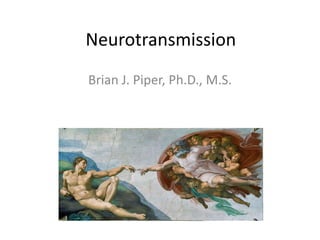
Neurotransmission
- 1. Neurotransmission Brian J. Piper, Ph.D., M.S.
- 2. Goals • Introduction to neurocommunication • Families of receptors (2) • Inactivation of neurotransmission (3)
- 3. Otto Loewi • Discovered “Vagusstoff” later known as acetylcholine • “father of neuroscience” • Nobel Prize 1936
- 5. Types of Synapses • Electron Microscope: Beams of electrons are presented to a thin section, 50 pm (10-12) resolution
- 7. Neurotransmitter Criteria • 1) Found and made presynaptically. • 2) Mechanism for inactivation. • 3) Stimulating neuron releases it. • 4) Receptors found postsynaptically. • 5) Applying substance has biological effect. • 6) Antagonizing inhibits biological effect. “neuromodulators”: don’t meet all criteria 1 to 6
- 8. Classical Neurotransmitters • Amino Acids: GABA, Glutamate • Monoamines: dopamine, norepinephrine, serotonin • Acetylcholine (ACh)
- 9. “Dale’s Principle” • Old View: Each neuron releases one, and only one, neurotransmitter (-ergic) • New View: neurons typically contain two+ neurotransmitters (classical & non-classical) Henry Dale, M.D. 1875-1963
- 10. Non-Classical Transmitters • Peptides: short (<50) strings of amino acids, Valine-Glycine-Serine-Alanine… e.g. NPY C terminal: COOH N terminal: NH2 Arginine, Proline, Lysine, Phenylalanine, Methionine, Histidine, Aspartic Acid, Valine
- 11. Non-classical Neurotransmitters • Peptides: Corticotropin-releasing factor (CRF), endorphins • Lipids: Anandamide • Gases: Nitric Oxide
- 12. Neurotransmitter Comparison Classical Non-Classical Discovery 1950’s 1980’s Concentration High Low # Few Many Synthesis Anywhere Soma
- 13. Co-Transmitters Amine/Amino Acid Peptide Dopamine Cholecystokinin (CCK) Norepinephrine enkephalin Epinephrine neurotensin Serotonin substance P Acetylcholine somatostatin Gamma aminobutyric acid (GABA) motilin Stahl, S. (2000). Essential Psychopharmacology, p. 20.
- 14. Axon Terminal
- 15. Brakes I: Inactivation of Neurotransmitter: • Enzyme: A + B __ENZ____> AB • Enzyme: CD __ENZ____> C + D
- 16. Brakes II • Autoreceptors: this receptor (“auto” = “self”) can act to inhibit further neurotransmission – Terminal (axon) autoreceptors: inhibit neurotransmitter release – Somatodendritic autoreceptors: reduce rate of action potentials
- 17. Brakes III: Transporters • Proteins that move molecule from one place to another, examples: – SERT: serotonin transporter – NET: norepinephrine transporter – DAT: dopamine transporter Inside ---------------------------------------------------------------------- Outside
- 18. Brakes III: Transporters • Structure: 12 transmembrane regions • What happens if you inhibit brakes?
- 20. Post-synaptic (Terminology Refresher) • Ligand: substance that binds to a receptor • Ion: atom where # electrons ≠ # protons – Ca2+ Na+ K+ – Cl- • First messenger: neurotransmitter • Second messenger: other molecule • Kinase: enzyme that adds phosphate (PO4)
- 21. So Many Receptors! Serotonin (5-HT): 1 2 3 4 5 6 7
- 22. Family 1: Ionotropic • Binding to receptor opens channel to let ions in (aka: ligand gated ion receptors)
- 23. Family 1: Ionotropic • Binding to receptor opens channel to let ions in (aka: ligand gated ion receptors) 0:40 – 6:20: http://www.youtube.com/watch?v=8jPH2pKzIDY
- 24. Allosteric Modulation • orthosteric: site where the neurotransmitter (A) binds to a receptor • allosteric: site where other molecule (B) binds, has no independent effect
- 25. Positive Allosteric Modulation • A+B>A • Example: Benzodiazepines Stahl (2008). Essentials of Psychopharmacology, p. 144.
- 26. Negative Allosteric Modulation • A+B<A • Example: clozapine Stahl (2008). Essentials of Psychopharmacology, p. 144.
- 27. Family 2: Metabotropic (2nd messenger) • Steps: • 1) Ligand binds receptor • 2) G protein acts on enzyme • 3) Enzyme regulates 2nd messenger • 4) 2nd messenger acts on protein kinase 6:30-9:00 http://www.youtube.com/watch?v=8jPH2pKzIDY
- 28. Family 2: Metabotropic (Channel) • Steps: • 1) Ligand binds receptor • 2) G protein alters channel • 3) ions flow out of neuron
- 29. Receptor Families Compared Ionotropic Metabotropic (nACh, GABA-A, 5-HT3, NMDA) ( M1, D2, alpha1,2, GABA-B) Subunits 4-5 1 Mechanism Simple: Channel opening Complex: G protein cascade 2nd messengers No Yes Speed Fast (msec) Slow (hours – week) Meyer & Quenzer (2005). p 73
- 30. Family 3: Tyrosine Kinase • Steps: 1) Ligand (BDNF) binds to Trk receptor 2) Trk receptors come together, and phosphorylate each other
- 32. So many potential drug targets!!! Examples: 1) Tryptophan 6) Nicotine 10) MAO-I 11) SSRIs
- 33. Current Targets of Psychotropic Drugs • Metabotropic Receptors (30%) • Transporters (30%) • Ion Channels (30%) • Enzymes (10%) Stahl, S. (2008). Essential Psychopharmacology. p. 92.
- 34. General Adage • “every drug acts on at least two receptors, the one you know about and the one you don’t” • Solution: – Pharmacological: use selective agonists, problem: not available? – Knock-out: generate mouse, problem: developmental compensation • Temporally specific: gene inactivated at specific time (adulthood) • Tissue specific: gene inactivated in specific region/area
